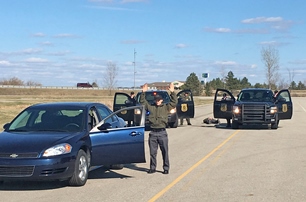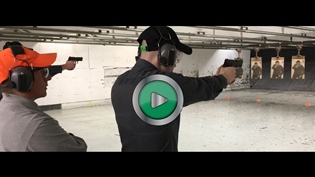Preparing for real-life situations
Week 12: March 20-26
 For 11 weeks, the Michigan Department of Natural Resources conservation officer academy recruits have tackled and conquered both physical and academic challenges. Week 12 would be no different. From completing training scenarios, to overcoming grueling morning physical training (PT) in “the tank,” to qualifying with their firearms, recruits faced the week’s challenges head on and as a team. For 11 weeks, the Michigan Department of Natural Resources conservation officer academy recruits have tackled and conquered both physical and academic challenges. Week 12 would be no different. From completing training scenarios, to overcoming grueling morning physical training (PT) in “the tank,” to qualifying with their firearms, recruits faced the week’s challenges head on and as a team.
Arrest procedures
After Monday morning PT, breakfast and inspection, recruits marched into the classroom. Retired Michigan State Police (MSP) inspector David Greydanus instructed the class on arrest procedures. Recruits focused on the option of issuing verbal warnings to offenders prior to issuing citations.
Recruits also learned about planning strategies for making arrests, evaluating the temperament and behavior of suspects, transporting suspects to jail, and more. The recruits also participated in a training scenario, conducting a traffic stop on a driver not wearing a seat belt. The passenger was found to have a warrant, and recruits were graded on identifying violations and making the arrest.
Body of the crime
Also Monday morning, recruits learned about laws of evidence, concentrating on investigation procedures and on evidence that is permissible in court. Recruits learned about corpus delicti, or body of the crime, referring to the principle that a crime must have been proven to have occurred before a person can be convicted of committing that crime. It all relates back to obtaining solid evidence.
Awareness
That afternoon, MSP contractor Phil Salinas taught the recruits – on an awareness level – about weapons of mass destruction. Recruits were presented with high-level information, such as the five types of weapons of mass destruction: chemical, radiological, biological, nuclear and explosive.
Traffic stops
 The remainder of the afternoon consisted of traffic-stop scenarios on the nearby MSP drive track. Recruit school staff (all conservation officers) pulled over vehicles driven by recruits. The trainees observed how each stop was handled to get a better idea of how different officers conduct traffic stops. The remainder of the afternoon consisted of traffic-stop scenarios on the nearby MSP drive track. Recruit school staff (all conservation officers) pulled over vehicles driven by recruits. The trainees observed how each stop was handled to get a better idea of how different officers conduct traffic stops.
Recruits also were introduced to felony traffic stops. Instructors used a PA system to order each person out of the vehicle separately. One by one, the “suspects” were taken into custody and searched. After securing them, a team advanced to search the vehicle.
“When backing up other law enforcement agencies on felony traffic stops, conservation officers will fully utilize this training,” said Conservation Officer (CO) Jeffrey Goss, recruit school staff.
Meat processor and taxidermy inspections
Tuesday morning, recruits received instruction from CO Goss on wild-game meat processor and taxidermist inspections, the first time this training has been conducted at a conservation officer academy.
Recruits were taught the laws regulating taxidermists and processors. Other topics of discussion included inspecting animal carcasses for the mechanism and time of death and checking for tagging violations.
Intoxicated-driver scenario
Wednesday morning, recruits reported to the classroom to learn more about laws of arrest. After instruction, they moved outdoors for a graded training scenario. It took place in a parking lot adjacent to the MSP training facility.
During the scenario, an intoxicated individual was found unconscious in the driver’s seat of a vehicle. Recruits determined what the violations were and decided how to handle the arrest and search of the vehicle. They had received instruction on Miranda rights during week 11 of training and utilized that information during the exercise.
Preparing in “the tank”
Physical training, held at 6 a.m. each day, became increasingly more challenging. While they still alternated some days in “the tank” – the nickname given to the 12-foot-deep swimming pool – with circuits in the gymnasium and running in formation outdoors, they spent more and more time in the pool. What is known as water safety week – a week filled with intense water-related exercises and tests – is soon approaching.
To prepare, recruits spent more time swimming laps in the pool without breaks and engaging in challenging exercises. One exercise involved retrieving a brick from the bottom of the pool while recruit school staff attempted to take the brick away from them – all while underwater.
“This simulates the physical challenges of rescuing someone who is drowning,” CO Goss said.
During water safety week, recruits will participate in a water safety test to rescue a simulated drowning victim who, because the victim is panicking, is making rescue more difficult.
“Every exercise the recruits engage in is meant to prepare them for real occurrences once they’re conservation officers,” CO Goss said.
 Traffic crash investigation Traffic crash investigation
Traffic crash investigation, taught by MSP Lt. Gary Megge, was back at the forefront Thursday morning. Lt. Megge focused on interviewing witnesses, determining if a crime had been committed, if citations (tickets) should be issued and/or if anyone should be arrested. Recruits also learned how to consult with medical personnel to determine injuries resulting from a traffic crash, how to obtain medical records and how to determine who was at fault.
Search warrants
Search warrant preparation training by CO Chris Holmes followed. Recruits learned how to build probable cause for a search warrant and the “four corners rule,” meaning that only the information written on the search warrant affidavit (within the four corners of the paper) can be used to determine whether or not a warrant is granted. They also learned about the process of conducting a search once the warrant and other required documentation are approved.
 Firearms training Firearms training
Tuesday, Wednesday and Thursday afternoons and all day Friday, recruits spent their time in the indoor MSP shooting range for firearms training.
They continued practicing what they had learned during the past several weeks, firing their Sig Sauer .40-caliber handguns at various distances, in low light and while kneeling, standing and behind barricades. View a short video of this training.
They also participated in a training scenario. In the scenario, which involved live simulation rounds, recruits backed up another law enforcement agency on a felonious assault complaint where the suspect yielded a knife and was found to be armed with a handgun. Recruits were graded on how well they were able to control the subject and make an arrest.
Qualification
Thursday afternoon was the much anticipated event. All the firearms training that had been done to this point – with over 1,000 rounds fired by each recruit during practice – was in preparation for this. Thursday marked the beginning of qualification with their Sig Sauer .40-caliber handgun – as required for all law enforcement officers through the Michigan Commission on Law Enforcement Standards (MCOLES). Qualification included all the components they’d been practicing. Recruits have multiple opportunities to qualify (pass). If they don’t, they are dismissed from the academy. They must meet the firearms requirements to become conservation officers, and they must requalify annually to maintain their certification.
Friday, recruits were introduced to their backup firearm, a Smith and Wesson .38-caliber revolver. They spent the full day in the shooting range getting used to the new firearm.
Team mentality
Despite so many challenges faced by the recruits, one thing was becoming more evident. They were becoming a cohesive team.
“When recruits first arrived at the academy, they came as individuals,” said CO Jeff Goss. “But as they’ve overcome each challenge throughout the past 11 weeks, I’ve seen them functioning more and more like a team. They’ve realized they need to work together, and that’s just what they’re doing.”
CO Goss added, “As recruits build bonds, they step up to support their fellow recruits, helping them overcome their weaknesses and build upon their strengths.”
Released at 5 p.m. Friday, recruits left the academy for the weekend, knowing they would have a short time to celebrate their successes of the week while anticipating the challenges of the next.
Subscribe to the weekly conservation officer academy blog, which also is posted weekly on the Michigan DNR Facebook page. View past blogs from Recruit School No. 7.
/Photo details: Accompanying photos are available below for download. Caption information follows.
Arrest procedures scenario.jpg: During the arrest procedures training scenario, recruits conducted a traffic stop on a driver not wearing a seat belt. The passenger was found to have a warrant, and recruits were graded on identifying violations and making the arrest.
Felony traffic stops.jpg: Recruit school instructors demonstrated a felony traffic stop during a training scenario.
Search warrant instruction.jpg: Conservation Officer Chris Holmes instructed recruits on how to build probable cause for a search warrant and the process of conducting a search once the warrant and other required documentation are approved.
Firing range practice.jpg: Recruits spent much of the week in the Michigan State Police shooting range, training for qualification with their Sig Sauer .40-caliber handgun./
The Michigan Department of Natural Resources is committed to the conservation, protection, management, use and enjoyment of the state’s natural and cultural resources for current and future generations. For more information, go to www.michigan.gov/dnr.
|

 For 11 weeks, the Michigan Department of Natural Resources conservation officer academy recruits have tackled and conquered both physical and academic challenges. Week 12 would be no different. From completing training scenarios, to overcoming grueling morning physical training (PT) in “the tank,” to qualifying with their firearms, recruits faced the week’s challenges head on and as a team.
For 11 weeks, the Michigan Department of Natural Resources conservation officer academy recruits have tackled and conquered both physical and academic challenges. Week 12 would be no different. From completing training scenarios, to overcoming grueling morning physical training (PT) in “the tank,” to qualifying with their firearms, recruits faced the week’s challenges head on and as a team. The remainder of the afternoon consisted of traffic-stop scenarios on the nearby MSP drive track. Recruit school staff (all conservation officers) pulled over vehicles driven by recruits. The trainees observed how each stop was handled to get a better idea of how different officers conduct traffic stops.
The remainder of the afternoon consisted of traffic-stop scenarios on the nearby MSP drive track. Recruit school staff (all conservation officers) pulled over vehicles driven by recruits. The trainees observed how each stop was handled to get a better idea of how different officers conduct traffic stops. Traffic crash investigation
Traffic crash investigation





